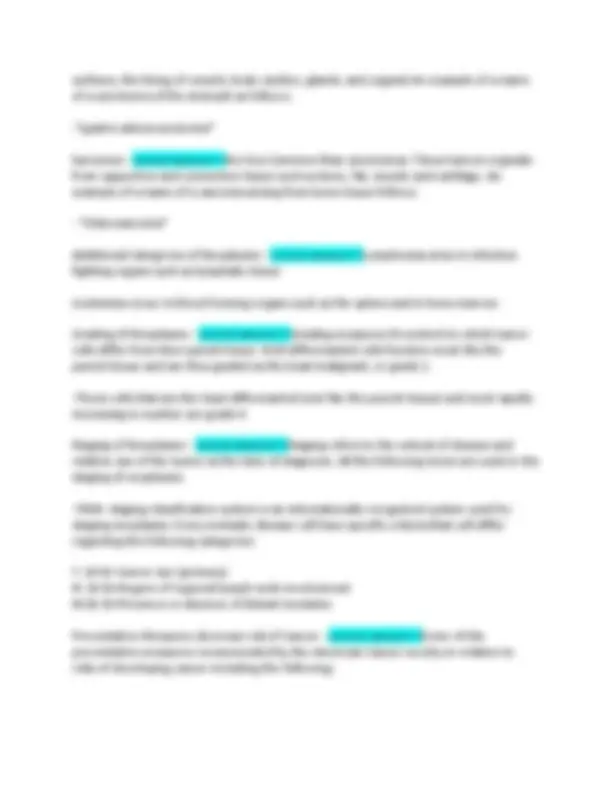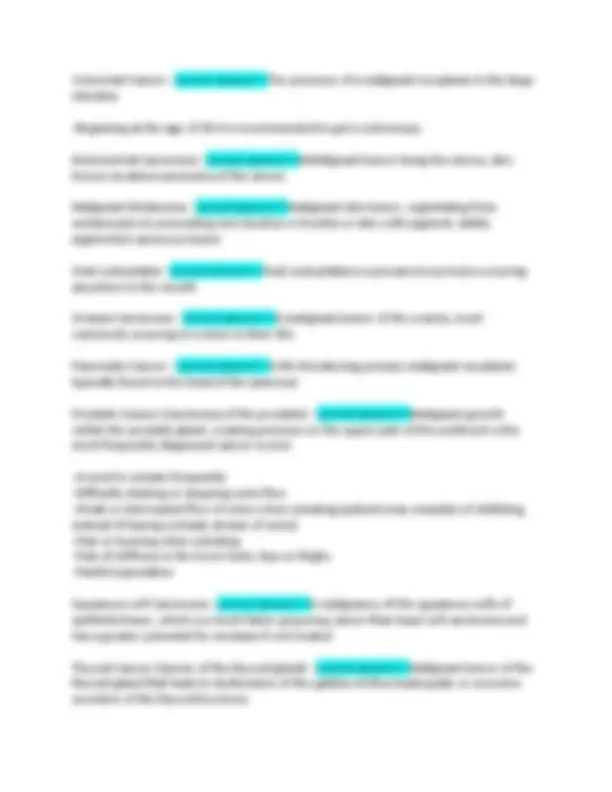







Study with the several resources on Docsity

Earn points by helping other students or get them with a premium plan


Prepare for your exams
Study with the several resources on Docsity

Earn points to download
Earn points by helping other students or get them with a premium plan
Community
Ask the community for help and clear up your study doubts
Discover the best universities in your country according to Docsity users
Free resources
Download our free guides on studying techniques, anxiety management strategies, and thesis advice from Docsity tutors
Anaplasia - correct answer>>A change in the structure and orientation of cells characterized by a loss of specialization and reversion to a more primitive form Benign - correct answer>>Noncancerous and therfore not an immediate threat, even thouhh treatment may be required for health or cosmetic reasons, not life threatening Cancer - correct answer>>A neoplasm characterized by the uncontrolled growth of anaplastic cells that tend to invade surrounding tissue and to metatisize to distant body sites Carcinogen - correct answer>>A substance or agent that causes the development or increases the incidence of cancer Carcinoma - correct answer>>A malignant neoplasm Carcinoma in the situ (CIS) - correct answer>>A premalignant neoplasm that has not invaded the basement membrane but shows cytologic characteristics of cancer Chemotherapy - correct answer>>The use of chemical agents to destroy cancer cells on a selective basis
Typology: Exams
1 / 9

This page cannot be seen from the preview
Don't miss anything!






Anaplasia - correct answer>>A change in the structure and orientation of cells characterized by a loss of specialization and reversion to a more primitive form Benign - correct answer>>Noncancerous and therfore not an immediate threat, even thouhh treatment may be required for health or cosmetic reasons, not life threatening Cancer - correct answer>>A neoplasm characterized by the uncontrolled growth of anaplastic cells that tend to invade surrounding tissue and to metatisize to distant body sites Carcinogen - correct answer>>A substance or agent that causes the development or increases the incidence of cancer Carcinoma - correct answer>>A malignant neoplasm Carcinoma in the situ (CIS) - correct answer>>A premalignant neoplasm that has not invaded the basement membrane but shows cytologic characteristics of cancer Chemotherapy - correct answer>>The use of chemical agents to destroy cancer cells on a selective basis Encapsulated - correct answer>>Enclosed in fibrous or membranous sheaths Invasive - correct answer>>Characterized by a tendence to spread,infiltrate and intrude Lumpectomy - correct answer>>Surgical removal of only the tumor and the immediate adjacent breast tissue, a method of treatrment for breast cancer when detected in the early stage of the disease Malignant - correct answer>>Tending to become worse and cause death Mestastasis - correct answer>>The process by which tumor cells spread to distant parts of the body Neoplasm - correct answer>>Any abnormal growth of new tissue, benign or malignant Radiation - correct answer>>The emission of energy, rays or waves
Relapse - correct answer>>To exhibit again the symptoms of a disease from whicha patient appears to have recovered Remission - correct answer>>The partial or complete disappearance of the symotoms of a chronic or malignant disease Staging - correct answer>>The determination of distinct phases or periods in the course of a disease Stem Cell - correct answer>>A formative cell whose daughter cells may give rise to other cell types Tumor - correct answer>>A new growth of tissue characterized by progressive, uncontrolled proliferation (growth) if cekks, The tumor may be localized or invasive, benign or malignant Benign Versus Malignant Tumors (Benign) - correct answer>>A benign tumor does not invade other tissues or mestatsisto other sites. Characteristics:
Colorectal Cancer - correct answer>>The presence of a malignant neoplasm in the large intestine
Replacement - correct answer>>To replace substances that the body is not producing sufficiently Diagnostic - correct answer>>To diagnose disease Preventative - correct answer>>To preven certain conditions Pharmacodynamics - correct answer>>The study of the mechanism of actions of drugs on living orgasnisms Drugg process - correct answer>>A drug must pass through four basic stages, absorption, distribution, metabolism and excretion Absorption - correct answer>>The process by which a drug ios absorbed into circulation (Small intestine) Metabolism - correct answer>>The process by which drugs are broken down into useful by products by enzymes in the liver. Adverse effect - correct answer>>A general term for an undesirable and potentially harmful side effect Anaphylaxis - correct answer>>A severe allergic respose to medication, involving respiratory distress Side effect - correct answer>>Am adverse drug effect that can be harmful or life threatening Antagonism - correct answer>>The combined effect of two drugs that is less than the effect of either drug taken alone Prophylaxis - correct answer>>A procedure of medication used to prevent a disease rather than to treat an existing one Half life - correct answer>>The amount of time required for 50% of the drug to be eliminated from the body Teratogen - correct answer>>A drug that causes birth defects. These drugs affect the x chromosome and therfore should not be given to pregnant women
Record keeping - correct answer>>A doctors office must maintain two types of records, dispensing and invetory. Dispensing records must indicate to whom, when and how much of he drug was administered or dispensed. Sublingual route - correct answer>>The drug is placed under the tongue and left there until it is dissolved Topical route - correct answer>>The drug is rubbed into, patted on, sprayed on, swabbed on, or rinsed on skin Poisons and their respective antidote Carbon Monoxide - correct answer>>Oxygen Poisons and their respective antidotes Cyanide - correct answer>>Amyl nitrite Poisons and their respective antidotes Opiates - correct answer>>Nalosone (Narcan) Parenteral route - correct answer>>The drug is injected into the body with a needle and syringe for rapid absorption and controlled dosage. Parenteral administration is a divided into four main categories (Intradermal, subcutaneous, intramuscular, intravenous) Antiobiotic - correct answer>>A chemical substance that destroys or interferes with the development of bacterial microorganisms Bactericidal - correct answer>>Destructive to or killing bacteria Bacteriostatic - correct answer>>Inhibiting the growth of bacteria Antimicrobial - correct answer>>Killing or inhibiting the growth of microorganisms Penicillin - correct answer>>Causes the higest incidents of drug allergies. Patients must be questioned about the possibility of a penicillin allergy Quinolone - correct answer>>A general class of broad spectrum antibiotics that interrupt the replication of DNA molecules in bacteria Tetracycline - correct answer>>A broad spectrum antibiotic that is effective against both gram-negative and gram positive microorganims